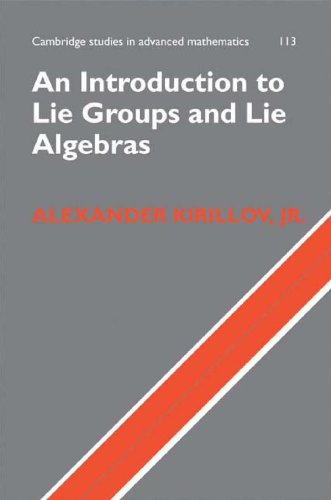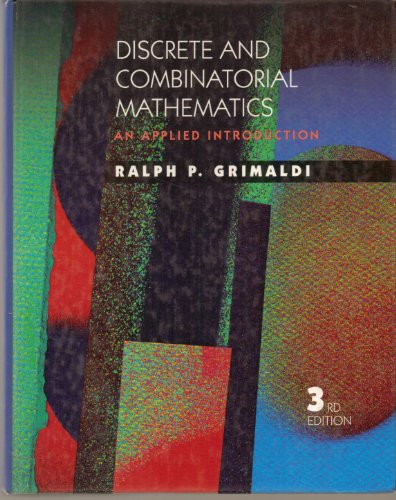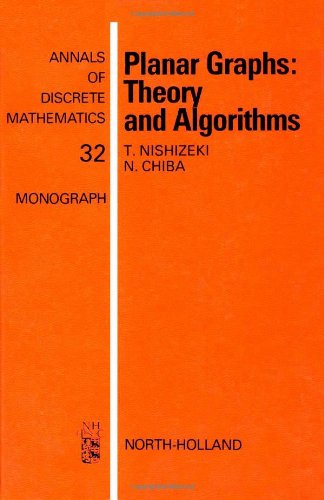Alexander Kirillov Jr0521889693, 9780521889698, 9780511424182
Table of contents :
Cover……Page 1
Dedication……Page 0
Title……Page 3
Copyright……Page 4
Contents……Page 5
Preface……Page 8
1 Introduction……Page 9
2.1 Reminders from differential geometry……Page 12
2.2 Lie groups, subgroups, and cosets……Page 13
2.4 Action of Lie groups on manifolds and representations……Page 18
2.5 Orbits and homogeneous spaces……Page 20
2.6 Left, right, and adjoint action……Page 22
2.7 Classical groups……Page 24
2.8 Exercises……Page 29
3.1 Exponential map……Page 33
3.2 The commutator……Page 36
3.3 Jacobi identity and the definition of a Lie algebra……Page 38
3.4 Subalgebras, ideals, and center……Page 40
3.5 Lie algebra of vector fields……Page 41
3.6 Stabilizers and the center……Page 44
3.7 Campbell-Hausdorff formula……Page 46
3.8 Fundamental theorems of Lie theory……Page 48
3.9 Complex and real forms……Page 52
3.10.1. Basis and commutation relations……Page 54
3.10.3. Isomorphisms……Page 55
3.11 Exercises……Page 56
4.1 Basic definitions……Page 60
4.2.1. Subrepresentations and quotients……Page 62
4.2.2. Direct sum and tensor product……Page 63
4.2.3. Invariants……Page 64
4.3 Irreducible representations……Page 65
4.4 Intertwining operators and Schur’s lemma……Page 67
4.5 Complete reducibility of unitary representations: representations of finite groups……Page 69
4.6 Haar measure on compact Lie groups……Page 70
4.7 Orthogonality of characters and Peter–Weyl theorem……Page 73
4.8 Representations of sl(2,C)……Page 78
4.9 Spherical Laplace operator and the hydrogen atom……Page 83
4.10 Exercises……Page 88
5.1 Universal enveloping algebra……Page 92
5.2 Poincare–Birkhoff–Witt theorem……Page 95
5.3 Ideals and commutant……Page 98
5.4 Solvable and nilpotent Lie algebras……Page 99
5.5 Lie’s and Engel’s theorems……Page 102
5.6 The radical. Semisimple and reductive algebras……Page 104
5.7 Invariant bilinear forms and semisimplicity of classical Lie algebras……Page 107
5.8 Killing form and Cartan’s criterion……Page 109
5.9 Jordan decomposition……Page 112
5.10 Exercises……Page 114
6.1 Properties of semisimple Lie algebras……Page 116
6.2 Relation with compact groups……Page 118
6.3 Complete reducibility of representations……Page 120
6.4 Semisimple elements and toral subalgebras……Page 124
6.5 Cartan subalgebra……Page 127
6.6 Root decomposition and root systems……Page 128
6.7 Regular elements and conjugacy of Cartan subalgebras……Page 134
6.8 Exercises……Page 138
7.1 Abstract root systems……Page 140
7.2 Automorphisms and the Weyl group……Page 142
7.3 Pairs of roots and rank two root systems……Page 143
7.4 Positive roots and simple roots……Page 145
7.5 Weight and root lattices……Page 148
7.6 Weyl chambers……Page 150
7.7 Simple reflections……Page 154
7.8 Dynkin diagrams and classification of root systems……Page 157
7.9 Serre relations and classification of semisimple Lie algebras……Page 162
7.10 Proof of the classification theorem in simply-laced case……Page 165
7.11 Exercises……Page 168
8.1 Weight decomposition and characters……Page 171
8.2 Highest weight representations and Verma modules……Page 175
8.3 Classification of irreducible finite-dimensional representations……Page 179
8.4 Bernstein–Gelfand–Gelfand resolution……Page 182
8.5 Weyl character formula……Page 185
8.6 Multiplicities……Page 190
8.7 Representations of………Page 191
8.8 Harish–Chandra isomorphism……Page 195
8.9 Proof of Theorem 8.25……Page 200
8.10 Exercises……Page 202
Basic textbooks……Page 205
Infinite-dimensional Lie groups and algebras……Page 206
Unitary infinite-dimensional representations……Page 207
Geometric representation theory……Page 208
Appendix A Root systems and simple Lie algebras……Page 210
Appendix B Sample syllabus……Page 218
Differential geometry……Page 221
Semisimple Lie algebras and root systems……Page 222
Representations of semisimple Lie algebras……Page 223
Bibliography……Page 224
Index……Page 228







Reviews
There are no reviews yet.